






Biographical Sketches
|
RICHARD NIXON Thirty-Seventh President • 1969-74 |
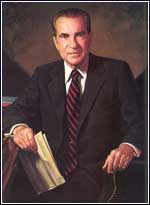 Richard Nixon | |
| ||
Reared by industrious Quaker parents, Richard Milhous Nixon was the second of five sons, two of whom died at early ages. He was born in 1913 at Yorba Linda, Calif. His father, who had worked at various jobs, earned a modest income by raising citrus crops. In 1922 the family moved to nearby Whittier. There, the senior Nixon, aided by his sons, operated a gas station-grocery.
Richard early showed interest in public speaking and drama, and took piano and violin lessons. He was a good student; participated in school debates, athletics, and politics; and played in the orchestra. In 1930 the youth graduated from Whittier Union High. In the fall, he entered Whittier College, a Quaker institution, but worked part time in his father's business to help finance his education. He majored in history, compiled an excellent academic record, was a member of the football squad, excelled in debating, and won the presidency of the student body. Ranking second in his class, in 1934 he received a B.A. degree. That same year, Nixon won a scholarship to Duke University Law School, in Durham, N.C. He was elected as president of the student bar association, and graduated with honors in 1937.
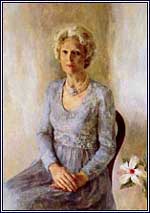 Patricia Nixon |
Returning to Whittier, later in the year Nixon was admitted to the bar and began practicing with a local firm. In 1938 he registered as a Republican, and 2 years later supported Presidential candidate Wendell Willkie. By 1941 Nixon had become assistant city attorney, a trustee of Whittier College, and president of two of his college alumni organizations. He also found time to organize a company that sought to freeze and market fresh orange juice, but despite his energetic management the business failed after 18 months. While acting in an amateur theater group, he met (Thelma C.) Patricia ("Pat") Ryan, a high-school business teacher. They married in 1940, and were to raise two daughters, Julie and "Tricia" (Patricia).
In 1942, not long after the outbreak of World War II, Nixon moved to Washington, D.C., to work for the tire-rationing section of the Office of Price Administration. That summer, though his religion made him eligible for conscientious-objector status, he enlisted in the Navy and was commissioned as a lieutenant junior grade. He held a variety of assignments, including those in supply and legal services. The highlight of these years, during which he attained the rank of lieutenant commander, was a 14-month tour of duty in the Pacific.
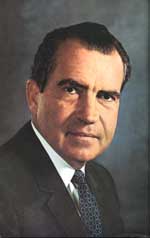 |
| Richard Nixon. (Photograph, 1968, by Robert S. Oakes.) |
Back home from the war, in 1946 Nixon ran for the U.S. House of Representatives, and in a hard-fought campaign defeated a powerful Democratic opponent who had held office for a decade. During his two terms, Nixon served on the Committee on Education and Labor, where he helped draft the Taft-Hartley Labor Relations Act of 1947; and won recognition as an anti-Communist crusader on the Committee on Un-American Activities. In 1950, after another bitter election battle, he won a seat in the U.S. Senate by a wide margin.
Dwight D. Eisenhower, Republican candidate for President in 1952, chose Nixon as his running mate. During the campaign, Nixon was accused of using political contributions for personal purposes, but his televised "Checkers" speech convinced Eisenhower and most citizens of his innocence. Inaugurated to the first of two terms as Vice President at the age of 40, Nixon was the second youngest man ever to hold the office.
When President Eisenhower was hospitalized on several occasions, Nixon chaired meetings of the Cabinet and National Security Council. He also represented the United States on good will trips to Latin America, the Soviet Union, and other places. In 1960 his party's national convention picked him to succeed Eisenhower, but in the first defeat of his political career he lost the general election to Democrat John F. Kennedy by a narrow margin.
The following year, Nixon moved back to California. Not long thereafter his Six Crises, which detailed decisive events in his career, was published. In 1962 he lost a bid for the governorship of his native State. The next year, he relocated to New York City and joined a distinguished law firm. Still campaigning for Republican causes, he remained a party leader, though he did not actively seek the Presidential nomination in 1964.
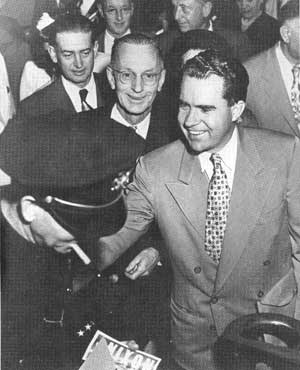 |
| Nixon during his successful campaign for the U.S. Senate in 1950. (National Park Service, Special Collection.) |
Four years later though, after being victorious in various primaries, Nixon was again nominated. He chose as his running mate Spiro T. Agnew, Governor of Maryland. Nixon narrowly defeated Democrat Hubert H. Humphrey and independent candidate George C. Wallace. Running for reelection in 1972 against Democratic Senator George McGovern, Nixon won the largest number of popular votes in the Nation's history.
Domestically, Nixon advocated a more powerful role for local government in his "New Federalism." His revenue-sharing system allocated a greater share of Federal funds to States and cities. Confronting balance of payments deficits in international trade and high rates of inflation, he instituted mandatory wage and price controls; entered into international monetary negotiations; devalued the dollar; and took steps to counter the energy crisis, which intensified late in 1973 when the Arab nations placed an embargo on oil. He also declared a "war" against crime and narcotics, opposed compulsory busing to desegregate schools, made four appointments to the Supreme Court, and ended the military draft while converting the armed services to an all-volunteer basis. A spectacular event early in his administration was the landing of American astronauts on the moon.
Aided by his chief international affairs adviser and later Secretary of State Henry A. Kissinger, Nixon pursued a vigorous foreign policy. In Viet-Nam he gradually reduced U.S. commitments while seeking to "Vietnamize" the conflict. In conjunction with the Saigon government of South Viet-Nam, he continued aerial and naval assaults on the North Vietnamese and their Indochinese allies and made incursions against their strongholds in Cambodia and Laos. He finally succeeded in disengaging U.S. forces and arranging for the release of American prisoners-of-war held by North Viet-Nam and the Viet Cong. These latter actions played an important part in ending large-scale demonstrations in the United States against participation in the war.
Outstanding among Nixon's travels to many parts of the world was his historic journey in 1972 to the People's Republic of China, the first high-level contact between the two nations in decades. He was the first President to visit that country while in office. The result was establishment of limited diplomatic contact between the two nations and creation of a spirit of amity. Later that same year and in 1974, the President traveled to the Soviet Union, where in a spirit of detente he signed a treaty to limit strategic nuclear weapons and discussed such other matters as cooperation in outer space, trade, and international affairs. In the Middle East, which he toured in 1974, he helped reduce tensions and the associated threat of world conflict.
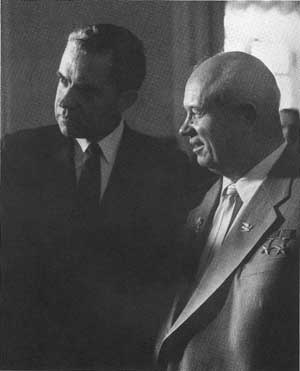 |
| Vice President Nixon and Soviet leader Nikita S. Khrushchev in 1959 at Moscow. (National Park Service, Special Collection.) |
Nixon's tenure was cut short by a series of scandals. These began with press revelations of political espionage involving certain members of his own special reelection committee. During June 1972 their agents had broken into the offices of the national committee of the Democratic Party at Washington's Watergate office building. As time went on, the "Watergate Affair" came to be associated with a wide variety of questionable activities on the part of the President and some of his Cabinet members, key aides, and campaign advisers. Congressional investigations and judicial proceedings resulted in the conviction of a number of them.
In a separate matter, in October 1973 Vice President Agnew resigned, after pleading "no contest" to tax fraud. Utilizing the untried procedures of the 25th amendment to the Constitution, Nixon nominated and Congress confirmed the appointment of Gerald R. Ford to the Vice-Presidency.
| HISTORIC SITES & BUILDINGS |
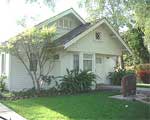 Nixon Birthplace |
One of the major discoveries made during the televised hearings of the Senate Select Committee on Presidential Campaign Activities was the existence of a tape-recording system in the White House. Ultimately, in one of the gravest constitutional crises in our history, the Supreme Court unanimously overruled Nixon's assertion of executive privilege to resist the subpoenas of Watergate prosecutors and ordered him to produce tapes and documents relevant to court proceedings.
Late in July 1974 the House Judiciary Committee publicly debated over television the charges against the President in preparation for full House impeachment. The committee finally recommended three articles: obstruction of justice, abuse of power, and contempt of Congress.
Under pressure from his own legal counsel, on August 5, 1974, Nixon surrendered three transcripts of conversations recorded in the White House a few days after the Watergate break-in. The implications of Nixon's involvement quickly eroded his remaining congressional support, and Republican leaders urged that he step down. On August 9, 1974, stating that he wished to spare the Nation further stress, Nixon resigned and retired to his home in San Clemente. He subsequently was given a full Presidential pardon. His wife Pat died in June 1993 and he died on April 22, 1994.
 |
 |
http://www.cr.nps.gov/history/online_books/presidents/bio37.htm
Last Updated: 04-Feb-2004